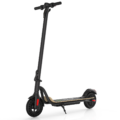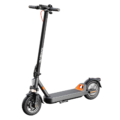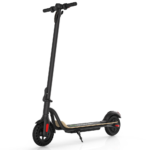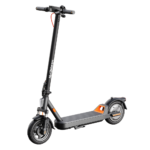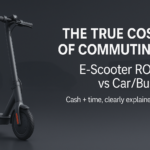- Home
- Scooters
- Electric Scooters
- MEGAWHEELS S1S
MEGAWHEELS S1S


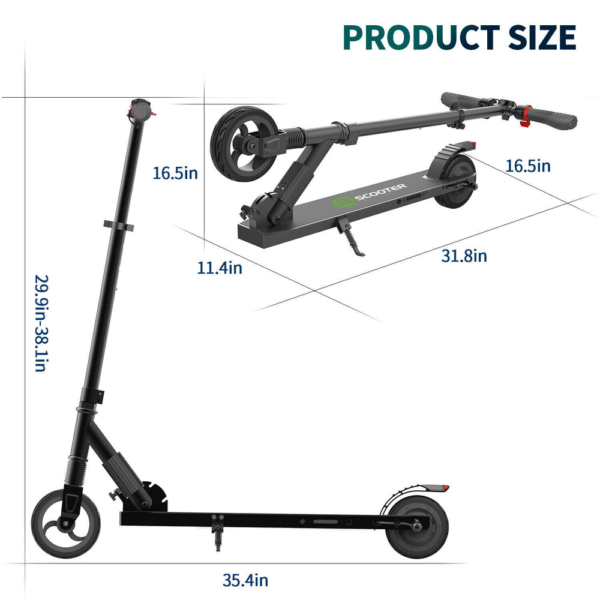
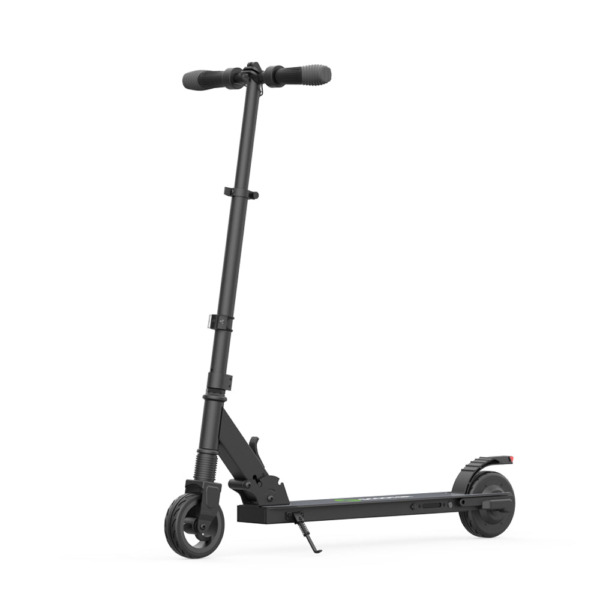
- Battery Range: 5–7.5 miles (8–12 km)
- Top Speed: 14 mph (23 km/h)
- Motor Power: 126 W
- Weight Capacity: 198 lb (90 kg)
- Charging Time: ~3 h
- Scooter Weight: 16.5 lb (7.5 kg)
PROS
- Ultra-light 16.5 lb design
- Height-adjustable handlebar
- 3 speed modes
- Folding, compact frame
CONS
- Short 5–7.5 mile range
- Small solid tires; firmer ride
- Electronic brake only
- IP rating not specified
Table of contents
- What Is the MEGAWHEELS S1S?
- How the MEGAWHEELS S1S Works
- Key Specifications (clean table)
- Design & Build Quality
- Performance Fundamentals
- Battery, Range & Efficiency
- Ride Quality & Comfort
- Braking & Safety Features
- Portability & Daily Usability
- Maintenance & Care
- Weather & Seasonal Considerations
- MEGAWHEELS S1S vs Alternatives
- Who the MEGAWHEELS S1S Is (and Isn’t) For
- FAQs
- Glossary
- Final Thoughts
If you want a truly lightweight electric scooter for short hops, the MEGAWHEELS S1S is built for exactly that. It’s compact, simple, and easy to carry, which makes it ideal for quick errands, campus shortcuts, and first-mile/last-mile rides. While it won’t rival larger commuter models for range or power, it delivers predictable performance in a tiny, beginner-friendly package. Moreover, it keeps maintenance low so you can focus on riding rather than wrenching.
What Is the MEGAWHEELS S1S?
The MEGAWHEELS S1S is a minimalist, foldable e-scooter designed around portability and ease of use. It trades long range and high speed for low weight and straightforward controls, so new riders can focus on balance, braking, and safe habits without a steep learning curve. Because the handlebar height adjusts, it fits a wide range of riders—especially teens and students—who need a grab-and-go ride that stows in a closet, under a desk, or in a car trunk. In short, it’s a practical micro-mobility tool rather than a performance machine.
Crucially, the S1S uses small, solid tires and a basic electronic brake. That combination reduces maintenance and keeps costs down. However, it also defines how and where the scooter feels best: smooth paths, short city blocks, and gentle grades. Consequently, if your routine involves elevators, buses, or stairs, the S1S’s very low weight becomes a daily advantage.
How the MEGAWHEELS S1S Works
At a glance, riding the S1S is simple: step on, push off, and press the thumb throttle to glide. Under the deck, a brushless hub motor spins the rear wheel. Meanwhile, a controller measures throttle input and regulates current from the battery so acceleration stays smooth rather than jerky. Think of it like a very polite dimmer switch that feeds power proportionally.
A compact lithium-ion battery powers the system. You charge it with a small plug-in charger; a control board manages the charging process and protects the cells from over-charging. Additionally, the handlebar houses the display and power button, while the throttle and brake controls sit within easy reach of your right thumb and left hand, respectively.
For stopping, the S1S uses an electronic brake that slows the motor. The motor acts like a generator, which creates a gentle retarding force. On this scooter, that electronic brake is the primary means of slowing down. The rear fender can be used for emergency stopping on many units, but it’s not the main brake and should be treated as a backup only. Therefore, plan your stops early and keep your weight centered.
Key Specifications (clean table)
Below is a clean, at-a-glance table that organizes the essential details in practical blocks. The specifications appear with both metric and imperial units for clarity.
| Block | Details |
|---|---|
| General | Model: S1S • Frame: Aluminum alloy • Net weight: 7.5 kg (≈16.5 lb) • Handlebar: height-adjustable • Deck height (platform): ~90 mm (≈3.5 in) |
| Performance & Power | Max speed: up to 23 km/h (≈14 mph) • Gradeability: up to ~15° (manufacturer figure) under ideal conditions • Motor type: brushless hub drive |
| Battery, Charging & Electrical | Battery capacity: 5.0 Ah at ~25.2 V (≈126 Wh) • Claimed range per charge: ~8–12 km (≈5–7.5 miles) • Charging time: ~3 hours • Working temp: about −15 to 50 °C (≈5 to 122 °F); charging temp: ~0 to 40 °C (≈32 to 104 °F) |
| Build & Dimensions | Tires: 6.0 in front / 5.5 in rear (solid) • Unfolded size: ~90 × 42 × (76–97) cm (≈35.4 × 16.5 × 29.9–38.2 in) • Folded: ~81 × 42 × 29 cm (≈31.9 × 16.5 × 11.4 in) • Max load: 90 kg (≈198 lb) |
| Safety & Control | Brake: electronic (primary) • Rear fender usable as an emergency stop on many units • Front and rear lighting present on most configurations • Reflectors as equipped |
| Features & Extras | Quick-fold latch • Tool kit in the box • Height-adjustable stem • Cruise Control: not listed for the S1S |
| Warranty & Compliance | Warranty handled by seller/manufacturer; terms vary by region. Charger and components carry standard conforming safety marks depending on market. Always check local riding rules before use. |
As you can see, these specifications emphasize compact size, low mass, and straightforward control components. Furthermore, the figures support the scooter’s focus on short, smooth rides rather than long, high-speed commutes.
Design & Build Quality
Frame and deck. The S1S frame is aluminum alloy, so it resists corrosion and keeps weight low. The deck sits close to the ground, which helps stability at modest speeds and makes it easy to step on and off at traffic lights. A low deck also lowers the rider’s center of gravity, which feels more planted on smooth pavement. Additionally, the deck’s simple, flat surface provides predictable foot placement.
Stem and latch. The stem folds via a quick-release mechanism and locks down to the rear fender for carrying. Because the scooter weighs roughly 7.5 kg, most adults can lift it with one hand, and even younger riders can manage a short carry with two. The height-adjustable handlebar is a standout feature here. It extends for taller riders yet collapses to a compact package for storage. Importantly, the latch works best when kept clean and occasionally lubricated.
Cockpit and controls. The layout is intentionally simple. You get a power button, a compact display that shows speed and battery, a thumb throttle for go, and the electronic brake control for stop. That minimal cockpit keeps things intuitive. Fewer gadgets means fewer distractions and fewer parts to rattle loose. Nevertheless, you should periodically check that the display bracket and grips remain tight.
Fit and finish. Budget scooters sometimes squeak or creak; the S1S’s small size actually helps minimize those noises, provided you snug down fasteners regularly. The solid tires eliminate tube pinch flats and keep the look tidy. However, solid rubber transmits bumps more directly than air-filled tires, so the ride feels firm. Therefore, rider stance and line choice matter more than on larger scooters.
Performance Fundamentals
Acceleration feel. Off the line, the S1S pulls gently and predictably. That’s intentional. A modest controller current limit keeps wheelspin in check and helps new riders build confidence. You won’t surge forward, yet you will reach neighborhood speeds in a short straight. Moreover, the linear throttle curve makes speed modulation easy in tight spaces.
Cruising stability. At 14 mph or less, the scooter feels calm on smooth pavement. The short wheelbase and low deck give it a planted, skate-like stance. Because the tires are small, obstacles feel larger than they would on a big-wheel scooter. Therefore, scan ahead, choose clean lines around cracks, and slow down for curbs or rough patches. In practice, that approach keeps the ride composed and predictable.
Hill-climb behavior. On mild grades—think 7–10% residential hills—the S1S will climb if you enter with a little speed. On longer or steeper climbs, expect speed to drop. Light riders will notice better results; heavier riders will need to kick-assist. This is normal for ultra-light e-scooters with small motors and compact batteries. Consequently, route planning pays off on hilly commutes.
Top-speed manners. Approaching the scooter’s 23 km/h limit, steering stays stable as long as the surface is smooth and your stance is relaxed. Keep your knees loose, weight centered, and elbows slightly bent. That posture dampens road buzz and gives you better control if a bump appears. Additionally, a steady throttle hand avoids sudden weight shifts.
Battery, Range & Efficiency
Capacity and energy. The S1S runs a lithium-ion pack rated around 5.0 Ah at about 25.2 V, which works out to roughly 126 Wh of energy. That’s a small, city-focused battery designed for short rides and fast top-ups between trips. As a result, it suits multi-stop days better than long single legs.
Rated vs. real-world range. The stated range is 8–12 km (about 5–7.5 miles) per charge in ideal conditions. Real-world range depends on rider weight, terrain, temperature, and speed. For example, a 60–70 kg rider on flat, warm pavement who cruises at jogging pace will sit near the top of the window. A heavier rider, colder temperatures, frequent stops, hills, or continuous full-throttle riding will sit nearer the bottom. Even so, thoughtful pacing can keep you within a useful envelope.
How to stretch range. Smooth throttle inputs help a lot. Maintain a steady pace instead of sprinting between lights. Coast whenever you can, and add a light kick on gentle hills to keep the controller out of the battery-hungry high-current zone. Keeping tires in good condition and fasteners tight also reduces rolling losses and squeaks that tempt you to brake and accelerate repeatedly. In addition, avoid long, unnecessary idling with the display on.
Charging habits. A typical full charge takes about three hours from low battery. For longevity, avoid deep discharges. If you’ll store the scooter for more than a week, park it around half charge in a cool, dry place. Lithium-ion packs prefer partial charges; frequent top-ups before short rides are fine and can extend usable life. Finally, let the scooter cool for a few minutes before charging after a hot summer ride.
Temperature effects. Expect reduced performance below freezing and during very hot afternoons. Cold increases internal resistance, which cuts power and range. High heat stresses cells, so let the scooter cool before charging after a summer ride. Moderation helps, so plan rides during milder parts of the day when possible.
Ride Quality & Comfort
Tires and feel. The S1S’s solid tires are the definition of low maintenance. They cannot puncture, and they hold their shape. The trade-off is a firmer feel over cracks and expansion joints. Because wheel diameters are 6.0 inches front and 5.5 inches rear, you should treat obstacles with respect. Take shallow angles across seams, and slow down for broken pavement. Likewise, keep your knees slightly bent to absorb chatter.
Suspension. There’s no traditional suspension here. Comfort therefore comes from rider technique. A soft-knee, athletic stance smooths out chatter. When you see a bump, shift weight slightly to your rear foot and unweight the front wheel a little. That subtle move reduces the sharpness you feel in your hands. Additionally, maintain a relaxed grip to avoid arm fatigue.
Ergonomics. The height-adjustable stem is a comfort win. Set the grips roughly at the height of your hip bones or slightly above for balanced control. Too high and you’ll strain your shoulders; too low and you’ll hunch and load your wrists. Because the deck is low, hopping on and off at lights feels natural. Moreover, the narrow bar width suits tight urban gaps.
Noise and vibration. Solid tires transmit more road texture. However, the S1S’s compact frame helps limit flex, so once you tighten the key bolts, rattles stay modest. A monthly check of the folding latch, stem clamps, axle hardware, and fender screws keeps the ride quiet. As a bonus, a clean, tight scooter also feels sharper at turn-in.
Braking & Safety Features
Electronic brake. The primary stopping system is an electronic brake that uses the motor to slow the wheel. The bite ramps progressively, which is beginner-friendly. Plan your stops early, and squeeze the control smoothly. Because this system relies on motor resistance, it works best at moderate speeds and on dry surfaces. Consequently, anticipate intersections and roll off early.
Rear fender as backup. On many S1-series units, the rear fender can serve as an emergency stomp brake. Treat it as a last resort. It can help scrub off speed if the electronic brake is overwhelmed on a short, steep descent or if traction is poor. However, relying on the fender can wear parts quickly; steady, early braking with the electronic system is the smarter habit. Still, practicing a gentle fender press in a safe area builds familiarity.
Lights and reflectors. The scooter typically includes a front LED for visibility and a rear light integrated into the fender area, plus reflectors where required in your region. These are “be-seen” lights rather than bright headlights. Therefore, reduce speed at night and ride on well-lit routes. Additionally, wear reflective elements on your clothing to boost conspicuity.
IP rating. The S1S is a fair-weather ride. It does not advertise a formal ingress protection rating, so avoid puddles and heavy rain. If you must roll across a damp patch, ride slowly and brake early; solid tires can feel skittish on wet painted lines and metal grates. As always, caution beats speed when traction drops.
Protective gear. A well-fitting bicycle helmet is non-negotiable. Gloves help with grip and comfort. If you’re new, consider knee and elbow pads during your first week to build confidence. Over time, you can pare gear back as skills improve, but keep the helmet every ride.
Portability & Daily Usability
Carry-anywhere weight. At roughly 7.5 kg (16.5 lb), the S1S is among the easiest electric scooters to carry up stairs. You can hold it by the folded stem in one hand and a backpack in the other. That makes quick transfers to buses and trains painless. Furthermore, the light mass encourages frequent short trips you might otherwise skip.
Fold and stow. The fold latch is quick, and the package tucks into a car trunk, dorm closet, or office corner. The folded size of about 81 × 42 × 29 cm (31.9 × 16.5 × 11.4 in) means it also slips under many desks. Because the handlebar height adjusts, you can choose the smallest storage footprint when space is tight. For best results, latch the stem securely to avoid scuffs during transport.
Security habits. Lightweight scooters are easier to lift—by you and by thieves. Bring it inside when you can. If you must lock it, use a quality lock around a fixed object through the frame, and never leave it unattended outdoors overnight. Engraving an identifier and snapping photos of serial markings can help with recovery if the worst happens. Additionally, avoid leaving the charger visible near public racks.
Daily routine. Many riders treat the S1S like an urban “connector.” Ride from home to a bus stop, fold for the ride, then unfold for the last three blocks to work or class. Because the charger is small, you can keep one at home and one at your desk to top up between trips. Ultimately, the less you think about logistics, the more you’ll ride.
Maintenance & Care
Fastener checks. Put a monthly reminder on your calendar to check the stem clamp, folding latch, handlebar clamp, wheel axles, and fender screws. A quarter-turn now prevents squeaks later. Additionally, dab a little thread locker on stubborn bolts if they loosen repeatedly.
Tires. Solid tires eliminate punctures and air checks. Inspect them monthly for embedded debris and uneven wear. Replace when the tread becomes slick or when you notice cracks that reach deep into the rubber. Meanwhile, keep an eye on the rear tire; drive wheels often wear faster.
Brakes. Electronic systems need little maintenance, but you still want to test stopping power before each ride. If your scooter has a fender brake, ensure the fender is not cracked and the hinge is tight. As a habit, practice progressive braking in an empty lot to calibrate your timing.
Battery and charging. Charge after rides that drop the battery below ~30–40%. Avoid leaving it fully depleted. For storage beyond a week, aim for about 50–60% charge in a cool, dry place. If you won’t ride for a month or more, top up briefly every few weeks to keep the cells healthy. Moreover, avoid covering the deck vents while charging.
Simple schedule.
- Every ride: Quick visual inspection; test the brake; check lights.
- Weekly: Wipe down, especially after dusty rides. Confirm latch and clamps are snug.
- Monthly: Full bolt check; tire inspection; charging port cap condition.
- Seasonal: Deep clean; inspect wires for chafe; evaluate tire tread and fender integrity.
This cadence keeps the scooter quiet, tight, and dependable. Consequently, you spend more time riding and less time troubleshooting.
Weather & Seasonal Considerations
Rain. Because there’s no formal IP rating, treat rain as a cue to slow down or stop. If you’re already out when a drizzle begins, ride gently to a safe destination. Avoid puddles entirely; small wheels can hide deep holes. Additionally, dry the scooter before storing to protect connectors.
Cold. Below 10 °C (50 °F), range drops as the battery’s internal resistance rises. Pre-warm the scooter indoors before heading out, and avoid fast charging immediately after a cold ride. Expect mellow throttle response in winter—this is normal. Therefore, plan shorter routes and leave a margin.
Heat. On hot days, give the scooter a break between rides. Let the deck cool before charging. Store out of direct sun whenever possible. As a result, the battery will age more slowly and performance will remain consistent.
Storage. For multi-week breaks, clean the scooter, charge to roughly half, and store in a dry room. Do not leave it in a hot car or on a freezing balcony. Finally, cycle the battery with a short ride every month or so to keep it active.
MEGAWHEELS S1S vs Alternatives
Where the S1S excels. It’s about as portable as an electric scooter gets while still offering true motorized assist. If you value low weight, simple controls, and compact storage above all else, the S1S is a smart fit. It shines on short urban trips, campus pathways, and multimodal commutes where you carry the scooter often. In essence, convenience leads the design.
For a step up within the same family, consider the MEGAWHEELS C2, a commuter-leaning alternative that suits longer, everyday rides.
Typical commuter class. Larger commuter scooters trade weight for comfort and range. They usually bring 8–10 inch tires, stronger brakes, and packs in the 250–500 Wh range. Those models climb better and feel calmer on rough streets, but they’re heavier to carry up stairs. Consequently, they suit longer daily rides rather than short hops.
Performance and off-road class. Big-battery, dual-motor, or suspension scooters offer higher speed and long range, yet they are heavy and bulky. If you rarely need to carry your scooter and ride longer distances on mixed surfaces, those classes make sense. Conversely, if you value a featherweight partner for short trips, the S1S’s approach fits better.
Who should “size up.” Riders above the S1S’s load rating or those with long, hilly commutes will be happier with a mid-size model. If you regularly ride at night on dark streets, consider a scooter with brighter, higher-mounted headlights and larger tires. Ultimately, match your pick to your terrain and distance.
Who the MEGAWHEELS S1S Is (and Isn’t) For
Ideal for:
- Students, teens, and lighter adult riders who need a quick, portable ride.
- City dwellers who pair scooters with public transit.
- Owners who prioritize low maintenance and simple operation.
- Short-distance errands, campus loops, and neighborhood leisure rides.
Not ideal for:
- Daily long-range commutes or frequent 10%+ hills.
- Heavy riders above the 90 kg (≈198 lb) limit.
- Rough, broken pavement or off-road paths where bigger wheels and suspension are safer.
- Rain-or-shine riders who need verified water protection.
Accordingly, choose the S1S if you want a compact, easily carried ride for short, predictable routes. Otherwise, consider moving up a class for comfort and capability.
FAQs
1) Is there a simple “MEGAWHEELS S1S overview” I can skim?
Yes. It’s a lightweight, foldable e-scooter with a 5.0 Ah battery, up to about 23 km/h (≈14 mph) top speed, and a claimed 8–12 km (≈5–7.5 miles) range. It prioritizes easy carrying and low maintenance over power and long distance.
2) Can beginners ride the S1S confidently?
Absolutely. Acceleration is gentle, the deck is low, and controls are straightforward. Start in open areas, practice braking early, and build speed gradually. Consequently, most new riders feel comfortable within a few short sessions.
3) How does it handle hills?
On short 7–10% grades, it climbs with a rolling start—especially for lighter riders. On longer or steeper hills, expect to slow and consider a kick assist. Therefore, plan routes that limit long climbs.
4) Does the S1S have Cruise Control?
No. The S1S keeps features minimal. You control speed with the thumb throttle and manage stops with the electronic brake. For many riders, that simplicity reduces distraction.
5) What about rain and puddles?
Treat it as a dry-weather scooter. Without a stated IP rating, avoid heavy rain and standing water. If a ride turns wet, slow down and head for shelter. Additionally, dry the scooter before storing.
6) Are the tires puncture-proof?
Yes. They’re solid rubber (6.0 in front, 5.5 in rear), so flats from nails or glass aren’t an issue. The trade-off is a firmer ride on rough surfaces. Even so, good technique smooths things out.
7) How long does a full charge take?
Roughly three hours from low battery. Partial top-ups are battery-friendly and practical for short daily trips. Finally, avoid charging immediately after hard, hot rides.
Glossary
- Ah (Ampere-hour): A measure of battery capacity. Higher Ah usually means longer run time at the same voltage.
- Wh (Watt-hour): Battery energy (voltage × capacity). A better indicator of range than Ah alone.
- Controller: The electronic “brain” that meters power from the battery to the motor.
- Brushless hub motor: A motor built into the wheel; efficient, sealed, and low maintenance.
- Regen (regenerative braking): Using the motor to slow the wheel and recover a little energy as electricity.
- Electronic brake: A brake that slows the motor electronically rather than by pads on a disc.
- Fender (stomp) brake: Pressing the rear fender against the wheel to add friction—primarily for emergencies on this scooter.
- Stem flex: The slight bending you feel in the handlebar stem under load. Less flex feels more precise.
- IP rating: An official ingress protection rating against dust and water. The S1S doesn’t state one.
- Grade: The steepness of a hill. A 10% grade rises 10 meters for every 100 meters forward.
- Deck height: Distance from ground to standing platform; lower often feels more stable.
- Solid tire: A tire without an inner tube; it cannot puncture but rides firmer.
- Kick assist: Using a foot push to help the motor on hills or from a stop.
- State of charge (SoC): How full the battery is, expressed as a percentage.
- Thermal soak: Heat buildup in components after continuous use; let parts cool before charging.
Final Thoughts
The MEGAWHEELS S1S is a purpose-built scooter for short, simple rides. Because it weighs so little, it goes where many scooters can’t—into classrooms, onto trains, or up multiple flights of stairs without drama. It asks you to accept a firm ride and modest hill ability in exchange for true grab-and-go convenience. If those trade-offs match your routine, it’s a tidy, low-maintenance way to add efficient micro-mobility to your day. Ultimately, it’s a tool for everyday convenience rather than weekend thrills.
Specifications
General
| Model The Model specifies the exact version or name of the scooter. It helps identify its unique design, features, and specifications within the manufacturer’s product line. Knowing the model makes it easier to compare options, find compatible accessories, or look up support information. | S1S |
| Brand The Brand identifies the manufacturer or company that designs and produces the scooter. A trusted brand is a sign of quality, reliability, and good customer support. Well-known brands often have higher standards for safety, performance, and after-sales service, giving you more confidence in your purchase. | MEGAWHEELS |
| Release Date The Release Date indicates when the scooter model was officially launched on the market. This helps you know how current the design, technology, and features are. A newer release date often means updated components, improved performance, and the latest safety or smart features. | 17 November 2025 |
| Recommended Age Recommended Age indicates the minimum age range that the scooter is designed for, based on safety, size, and ease of use. Following the recommended age helps ensure that riders can handle the scooter’s speed, weight, and controls comfortably and safely. Always check local laws and use protective gear, especially for younger riders. | +16 |
Performance & Power
| Motor Power (Wattage) What it means: The motor power, measured in watts (W), shows how strong the scooter’s electric motor is. Why it matters: Higher wattage usually means better acceleration, more torque, and improved performance on hills or rough terrain. For example, a 250W motor is good for flat city roads and light riders, while a 500W or 1000W motor provides more power for faster speeds or climbing steep inclines. | 126 W brushless hub motor |
| Top Speed The Top Speed indicates the maximum speed that the scooter can reach under optimal conditions. It’s usually measured on level ground with a fully charged battery and an average rider weight. A higher top speed allows you to travel longer distances faster, but always ensure you ride within legal speed limits and your personal comfort zone for safety. | 14 mph (23 km/h) |
| Battery Capacity Battery Capacity refers to the total amount of energy the scooter’s battery can store, usually measured in ampere-hours (Ah) or watt-hours (Wh). A higher battery capacity means you can ride longer distances on a single charge, reducing the need for frequent recharging. Keep in mind that actual range can vary depending on rider weight, terrain, speed, and weather conditions. | 25.2 V 5.0 Ah (126 Wh) |
| Estimated Range per Charge The Estimated Range per Charge indicates the average distance the scooter can travel on a single full battery charge. This range is calculated under optimal conditions, such as flat terrain, moderate speed, and average rider weight. Real-world range may vary depending on riding style, terrain, weather, and load. A longer range means fewer recharges and greater freedom for longer trips. | 5–7.5 miles (8–12 km) |
| Hill Climb Ability Hill Climb Ability describes the maximum incline or slope that the scooter can handle while maintaining stable performance. It’s typically expressed as a percentage or in degrees. A higher hill climb rating means the scooter can tackle steeper hills without losing too much speed or power. Actual climbing performance may vary based on rider weight, battery charge, and terrain conditions. | 15% grade (stated) |
| Drive System The Drive System refers to how power from the motor is delivered to the wheels. Electric scooters typically use either a hub motor (directly integrated into the wheel) or a chain/belt drive system. A high-quality drive system ensures smooth acceleration, efficient power transfer, and low maintenance. The choice of drive system affects performance, noise level, and overall ride experience. | Not specified |
Charging & Electrical
| Charging Time Charging Time indicates how long it takes to fully recharge the scooter’s battery from empty to 100% using the standard charger provided. Faster charging means less downtime and more time on the road. Actual charging time may vary slightly depending on battery capacity, charger output, and environmental conditions. | Approx. 3 hours |
| Battery Type Battery Type refers to the specific technology used in the scooter’s battery, which affects performance, lifespan, weight, and charging time. Most modern electric scooters use high-quality lithium-ion (Li-ion) batteries because they offer a good balance of energy density, durability, and low maintenance. A reliable battery type ensures consistent power delivery and longer riding ranges. | Lithium-ion battery |
| Removable Battery A Removable Battery means the battery pack can be easily detached from the scooter for convenient charging and replacement. This feature allows you to charge the battery separately, swap it with a spare for extended range, or securely store it indoors in extreme weather. Removable batteries add flexibility and make it easier to keep your scooter powered up wherever you are. | Non-removable internal battery (fixed pack) |
| Regenerative Braking Regenerative Braking is an energy-saving feature that converts some of the energy normally lost during braking back into battery power. When you slow down or brake, the motor works in reverse to generate electricity, which helps extend the scooter’s range and improves overall efficiency. This system also reduces wear on traditional brake components, leading to lower maintenance over time. | Not specified |
| Lighting Lighting refers to the built-in front and rear lights that enhance visibility and safety when riding in low-light conditions or at night. Good lighting helps you see the road ahead and ensures that other road users can see you. Many scooters include LED headlights, taillights, and sometimes brake lights or side reflectors for added safety and compliance with local traffic regulations. | Not specified |
Build & Dimensions
| Scooter Weight Scooter Weight refers to the total weight of the scooter when fully assembled, including the battery. This affects how easy it is to carry, lift, and store the scooter when not in use. A lighter scooter is more portable and convenient for commuting, especially if you need to carry it upstairs or onto public transport. Keep in mind that a sturdy frame and quality components may add to the weight but also contribute to better durability and ride stability. | 16.5 lb (7.5 kg) |
| Maximum Rider Weight Maximum Rider Weight indicates the highest rider weight that the scooter is designed to safely support while maintaining optimal performance and stability. Staying within this limit helps ensure reliable acceleration, braking, and climbing ability, and it protects the frame, suspension, and motor from excessive strain. Exceeding the recommended limit may reduce performance and increase wear on components. | 198 lb (90 kg) |
| Deck Size Deck Size refers to the dimensions of the scooter’s standing platform. A wider and longer deck provides more foot space, allowing you to stand comfortably and adjust your stance while riding. A well-sized deck improves balance and stability, especially on longer rides or at higher speeds. Compact decks, on the other hand, help keep the scooter lightweight and portable. | Low deck; compact frame; height-adjustable bar |
| Handlebar Height Handlebar Height refers to the distance from the deck to the handlebars, which affects your riding posture and comfort. An appropriate handlebar height helps you maintain good balance, reduces strain on your back and arms, and makes steering more comfortable. Some scooters have adjustable handlebars to fit riders of different heights, while others have a fixed height for a streamlined design. | Adjustable: 29.9–38.2 in (76–97 cm) |
| Folding Mechanism The Folding Mechanism describes how easily and securely the scooter can be folded for carrying and storage. A well-designed folding system lets you quickly collapse the scooter into a compact size, making it convenient to transport on public transit, store under a desk, or fit into a car trunk. Look for sturdy latches and safety locks to ensure the scooter stays firmly in place when folded or unfolded. | Foldable (mechanism not specified) |
| Dimensions Folded Dimensions indicate the size of the scooter when it’s fully folded. This measurement shows how much space the scooter will take up when stored or carried, making it easier to check if it will fit in your car trunk, under a desk, or in a closet. Compact folded dimensions are ideal for commuters who need to bring their scooter on public transport or store it in tight spaces. | Unfolded: 35.4 × 16.5 × 29.9–38.2 in; Folded: 35.4 × 16.5 × 11.4 in |
| Material Material refers to the primary construction materials used for the scooter’s frame and key components. High-quality materials like aircraft-grade aluminum, reinforced steel, or durable composites provide strength, stability, and a lighter overall weight. A sturdy material ensures the scooter can handle daily wear and tear while maintaining safety and performance. | Aluminum alloy |
Safety & Control
| Brake Type(s) Brake Type(s) describe the braking systems the scooter uses to help you slow down or stop safely. Common brake types include mechanical brakes (like drum or disc brakes), electronic brakes, and foot brakes. Many scooters combine multiple braking systems for added safety and shorter stopping distances. The type and quality of brakes affect your control, especially when riding at higher speeds or on slopes. | Electronic brake |
| Suspension Suspension refers to the system that absorbs shocks and vibrations while riding, providing a smoother and more comfortable ride over uneven or rough surfaces. Scooters may have front suspension, rear suspension, or dual suspension for better shock absorption and stability. Good suspension helps reduce rider fatigue and improves control, especially when riding on bumpy roads or off-road paths. | None |
| Tire Type Tire Type refers to the kind of tires the scooter uses, which directly affects ride comfort, traction, and maintenance. Common types include solid (airless) tires, pneumatic (air-filled) tires, or hybrid options. Pneumatic tires offer better shock absorption and a smoother ride on rough surfaces, while solid tires are puncture-proof and require less upkeep. The right tire type helps ensure safe handling and a comfortable ride in different conditions. | 6″ front & 5.5″ rear solid tires |
| Tire Size Tire Size indicates the diameter and width of the scooter’s tires, which affect ride comfort, stability, and how well the scooter handles different terrains. Larger tires generally offer better shock absorption and a smoother ride over bumps and rough surfaces, while smaller tires keep the scooter lighter and more portable. Choosing the right tire size helps ensure a balance between agility and comfort. | 6-inch front / 5.5-inch rear |
| Kickstand The Kickstand is a built-in stand that allows you to park your scooter upright when it’s not in use. A sturdy kickstand keeps the scooter stable and prevents it from tipping over, protecting it from scratches and damage. It also makes storing and accessing your scooter more convenient, whether you’re at home, work, or on the go. | Not specified |
| Water Resistance Rating Water Resistance Rating indicates how well the scooter is protected against water and moisture, usually shown as an IP (Ingress Protection) rating. This rating helps you understand whether the scooter can handle light rain, splashes, or wet roads without damage. While most scooters are not fully waterproof, a good water resistance rating adds peace of mind when riding in changing weather conditions. Always avoid deep puddles or submerging the scooter to protect its electrical components. | Not specified |
Features & Extras
| Display/Console The Display (or Console) shows important real-time information about your ride, helping you monitor your scooter’s status at a glance. Typical displays show speed, battery level, distance traveled, and riding mode. Some models also include additional features like Bluetooth connectivity, app integration, or backlighting for better visibility at night. A clear and easy-to-read display enhances safety and convenience on every trip. | Not specified |
| Ride Modes Ride Modes refer to the different speed and power settings you can choose to match your riding style or road conditions. Common modes include eco for maximum range and energy efficiency, standard for everyday balance, and sport or turbo for higher speed and stronger acceleration. Switching between ride modes allows you to customize performance, conserve battery, and ride safely in various environments. | 3 speed modes |
| Smart App Connectivity Smart App Connectivity lets you pair your scooter with a dedicated mobile app via Bluetooth. Using the app, you can monitor real-time ride stats like speed, battery level, and range, adjust settings such as ride modes or cruise control, lock the scooter for added security, and sometimes receive firmware updates. This feature adds convenience and allows you to personalize your riding experience right from your smartphone. | No app |
| Anti-Theft System The Anti-Theft System helps protect your scooter from unauthorized use or theft. This feature can include built-in alarms, electronic motor locks, GPS tracking, or remote locking through a mobile app. A good anti-theft system provides peace of mind when parking your scooter in public spaces, adding an extra layer of security to safeguard your investment. | Not specified |
| Cruise Control Cruise Control allows you to maintain a steady speed without continuously holding the throttle. This feature makes longer rides more comfortable by reducing hand fatigue and providing a smoother, more relaxed riding experience — especially on flat, open roads or bike lanes. For safety, cruise control can usually be easily activated or deactivated while riding. | No |
| Accessories Included Accessories Included lists the additional items that come with the scooter to enhance your riding experience and convenience. Common accessories may include a charger, kickstand, bell, lights, phone holder, or carrying strap. These extras add value by making your scooter safer, easier to use, and ready to ride straight out of the box. | Not specified |
Warranty & Compliance
| Warranty Period The Warranty Period indicates how long the manufacturer guarantees the scooter against defects in materials and workmanship under normal use. A good warranty provides peace of mind, showing the brand’s confidence in its product quality. Always check what parts are covered, such as the frame, battery, and motor, and follow the maintenance guidelines to keep your warranty valid. | 12 months (region-dependent) |
| Certifications Certifications confirm that the scooter meets specific safety, quality, and environmental standards set by recognized organizations or regulatory bodies. Common certifications may include CE, RoHS, UL, or other local compliance marks, depending on your region. These certifications ensure that the scooter is manufactured to high standards and is safe and legal to use in your country. | Region-dependent |


